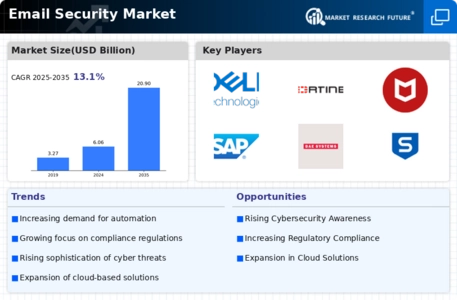Top Industry Leaders in the Email Security Market
Competitive Landscape of the Email Security Market
The email security market, a once-niche segment, has transformed into a bustling arena as email remains the primary communication channel for enterprises and individuals alike. The surge in cyber threats, particularly sophisticated phishing attacks and malware campaigns, has propelled the demand for robust security solutions. This demand presents both exciting opportunities and fierce competition for players navigating this labyrinthine landscape.
Competitive Landscape of the Email Security Market
- Cisco Systems, Inc (US),
- Dell, Inc (US), Fortinet (US)
- McAfee, Inc (US)
- Symantec Corporation (US)
- Appriver (US), Apptix (US)
- Microsoft Corporation (US)
- Mimicast (UK)
- SAP SE (US)
- BAE Systems (UK)
- Sophos (UK)
- Egress Software (UK)
- Entrust Datacard (US)
- FireEye
- Cryptzone (US)
Strategies Shaping the Battleground:
- Cloud-First Approach: The shift towards cloud-based email security solutions is undeniable. The agility, scalability, and centralized management offered by cloud platforms are winning over businesses. Established players are adapting their offerings, while nimble cloud-native providers capitalize on the trend.
- AI and Machine Learning (ML) Integration: Advanced AI and ML algorithms are revolutionizing email security by automating threat detection and response. Players are incorporating these technologies to identify sophisticated phishing attempts, zero-day malware campaigns, and other emergent threats, offering unparalleled protection.
- Integration and Interoperability: The need for seamless integration with existing security infrastructure and business applications is crucial. Players are focusing on APIs, open standards, and partnerships to ensure their solutions play well with others, creating comprehensive security ecosystems.
- Threat Intelligence Sharing and Collaboration: Collaboration between security vendors and the broader security community is critical in staying ahead of cybercriminals. Sharing threat intelligence allows for faster detection and mitigation of emerging threats, benefiting all stakeholders.
Factors Determining Market Share Dominance:
- Product Breadth and Depth: Offering a comprehensive suite of features like anti-spam, anti-malware, data loss prevention, and encryption remains a key differentiator. Players must address diverse security needs across various organization sizes and industries.
- Deployment Flexibility: Flexibility in deployment options, both cloud-based and on-premises, caters to a wider range of customers with varying technological infrastructure and preferences.
- Pricing and Value Proposition: Striking a balance between competitive pricing and delivering demonstrable value remains crucial. Players must tailor pricing models to different customer segments and budgets while showcasing the return on investment their solutions offer.
- Customer Service and Support: Timely and responsive customer service is paramount in a security landscape where every minute counts. Players must provide reliable support and technical assistance to ensure customer satisfaction and retention.
New Entrants and Emerging Trends:
- Zero-Trust Security: The zero-trust security model, emphasizing least privilege access and continuous verification, is gaining traction in email security. Companies are developing solutions that implement zero-trust principles to further harden defenses against unauthorized access.
- Email Authentication and Encryption Standards: Adoption of standards like DMARC and BIMI strengthens email authentication and protects against spoofing. Players are integrating these standards into their solutions to enhance email security and sender reputation.
- Security Awareness Training: Building a security-conscious workforce is critical in preventing human error-based attacks. Security awareness training platforms are increasingly integrated with email security solutions to educate employees and address the human factor in email security.
Investment Trends Shaping the Future:
- Consolidation and Acquisitions: As the market matures, consolidation through mergers and acquisitions is expected to reshape the landscape. Established players may acquire niche providers to bolster their offerings, while smaller players may join forces to compete more effectively.
- Focus on Automation and Intelligence: Investment in AI and ML for automated threat detection and response is a major focus area. Players are also investing in threat intelligence platforms and security orchestration, automation, and response (SOAR) solutions to automate security workflows and streamline operations.
- Growing Emphasis on Data Security and Privacy: Data privacy regulations like GDPR and CCPA are influencing email security solutions. Players are developing offerings that comply with these regulations and ensure secure data handling and encryption.
Latest Company Updates:
Dec 8, 2023: Zscaler reported a 58% year-over-year revenue increase, driven by strong demand for its cloud-based email security solutions. This further underscores the shift towards cloud adoption in the email security market.
Dec 15, 2023: Microsoft announced the integration of advanced AI algorithms into Defender for Office 365 to detect sophisticated phishing attacks with higher accuracy. This move strengthens Microsoft's position as a major player in the email security landscape.
Nov 30, 2023: Barracuda Networks acquired PhishMe, a leading security awareness training provider, to bolster its human-centric security approach. This highlights the growing importance of employee education in email security best practices.
Oct 26, 2023: Mimecast unveiled its new Zero-Trust Email Gateway solution, providing granular access control and continuous verification for email communications. This caters to the increasing demand for zero-trust principles in email security.
Oct 17, 2023: The Global Cyber Alliance launched the "PhishTank" platform, a collaborative initiative for sharing phishing domain and URL information among email security vendors and the cybersecurity community. This emphasizes the importance of collaboration in combatting email threats.

